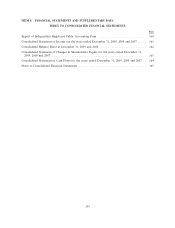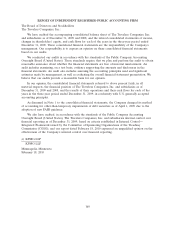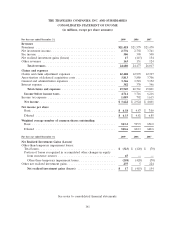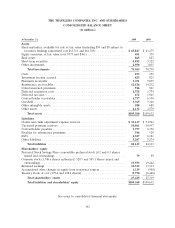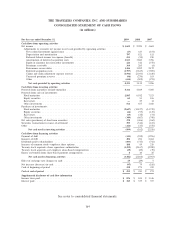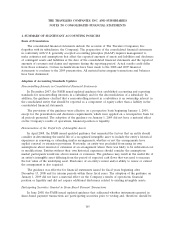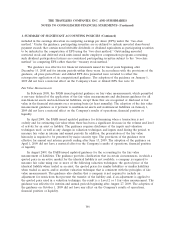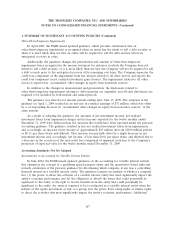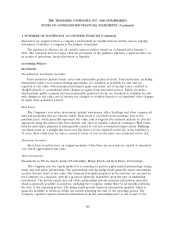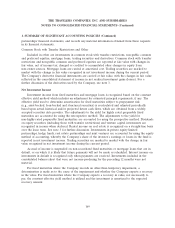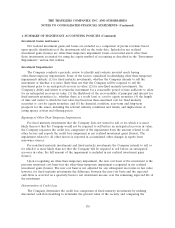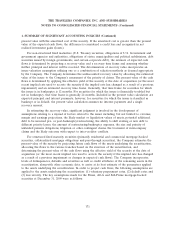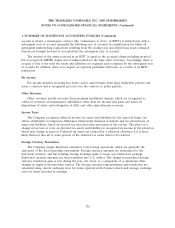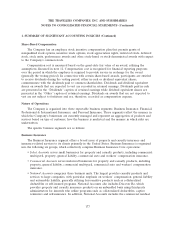Travelers 2009 Annual Report Download - page 179
Download and view the complete annual report
Please find page 179 of the 2009 Travelers annual report below. You can navigate through the pages in the report by either clicking on the pages listed below, or by using the keyword search tool below to find specific information within the annual report.THE TRAVELERS COMPANIES, INC. AND SUBSIDIARIES
NOTES TO CONSOLIDATED FINANCIAL STATEMENTS (Continued)
1. SUMMARY OF SIGNIFICANT ACCOUNTING POLICIES (Continued)
Other-Than-Temporary Impairments
In April 2009, the FASB issued updated guidance, which provides clarification that an
other-than-temporary impairment is recognized when an entity has the intent to sell a debt security or
when it is more likely than not that an entity will be required to sell the debt security before its
anticipated recovery in value.
Additionally, the guidance changes the presentation and amount of other-than-temporary
impairment losses recognized in the income statement for instances in which the Company does not
intend to sell a debt security, or it is more likely than not that the Company will not be required to sell
a debt security prior to the anticipated recovery of its remaining cost basis. The Company separates the
credit loss component of the impairment from the amount related to all other factors and reports the
credit loss component in net realized investment gains (losses). The impairment related to all other
factors is reported in ‘‘accumulated other changes in equity from nonowner sources.’’
In addition to the changes in measurement and presentation, the disclosures related to
other-than-temporary impairments relating to debt securities are expanded, and all such disclosures are
required to be included in both interim and annual periods.
The guidance was effective for interim periods ending after June 15, 2009. The adoption of the
guidance on April 1, 2009 resulted in an increase in retained earnings of $71 million, which was offset
by a corresponding decrease in ‘‘accumulated other changes in equity from nonowner sources’’ of the
same amount.
As a result of adopting the guidance, the amounts of net investment income, net realized
investment losses from impairment charges and net income reported for the twelve months ended
December 31, 2009 were different than the amounts that would have been reported under the previous
accounting guidance. The guidance resulted in less net realized investment losses from impairments,
and accordingly, an increase in net income of approximately $65 million after-tax ($100 million pretax)
or $0.11 per share (basic and diluted). That increase was partially offset by a slight decrease in net
investment income and, accordingly, net income, of less than $0.01 per share (basic and diluted) due to
a decrease in the accretion of the non-credit loss component of impaired securities to the Company’s
projection of expected value for the twelve months ended December 31, 2009.
Accounting Standards Not Yet Adopted
Amendments to Accounting for Variable Interest Entities
In June 2009, the FASB issued updated guidance on the accounting for variable interest entities
that eliminates the concept of a qualifying special-purpose entity and the quantitative-based risks and
rewards calculation of the previous guidance for determining which company, if any, has a controlling
financial interest in a variable interest entity. The guidance requires an analysis of whether a company
has: (1) the power to direct the activities of a variable interest entity that most significantly impact the
entity’s economic performance and (2) the obligation to absorb the losses that could potentially be
significant to the entity or the right to receive benefits from the entity that could potentially be
significant to the entity. An entity is required to be re-evaluated as a variable interest entity when the
holders of the equity investment at risk, as a group, lose the power from voting rights or similar rights
to direct the activities that most significantly impact the entity’s economic performance. Additional
167




